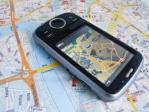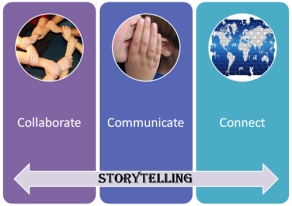http://video.pbs.org/video/1797357384/
1) Which project do you like the most or which project is the most impressive? Why?
I really liked the project where the students walked around downtown Middleton learning about its history. I want to teach history, so this project especially stuck out to me. I would love to use this project in my future classroom. I would have enjoyed this project when I was in school because you are getting to learn about your own town and can therefore relate it to your own life. The use of the GPS is a really smart way to get the kids using  media while still being active. I also thought it was really cool how the students researched an actual issue in the town (parking space) and even talked to the city planner about it. This kind of learning is real and authentic. Not only were the students learning about the history of Middleton, but they were also learning about how the town functions now.
media while still being active. I also thought it was really cool how the students researched an actual issue in the town (parking space) and even talked to the city planner about it. This kind of learning is real and authentic. Not only were the students learning about the history of Middleton, but they were also learning about how the town functions now.
2) Do you think you need to sharpen your digital medial skills? What are some challenges for you to use the digital media in your own learning/ teaching?
I know that I have lots of room to learn more about digital media. I am not an expert with any sort of media, and the tools/resources are constantly changing so I know I am not up to date with latest trend. In my mind, I often still relate digital media only with fun and entertainment, and not with schools or learning. The problem here is that learning should be fun and entertaining! That is exactly why digital media can be such a beneficial resource in the classroom. I do think, though, that digital media should only be used at certain times and in certain ways. It is not always the appropriate tool to be using. This certainly presents a challenge in knowing when and in what ways to use digital media in order to most benefit your students. There also comes the question of how much media your students have access to, and this also can present challenges.
3) Do these projects remind you of some ideas you learned from your reading (meaningful learning with technology chapter 1)? What are the ideas? How did you see the connections?
One connection I made between the video and the reading involves the depth to which technology can be used in the classroom. The reading talked about learning with technology, an idea that the video definitely displays in multiple different ways. All of the projects involved students working with technology and digital media to accomplish a larger goal. While they were using the technology, they were learning all other kinds of content and skills. The projects also showed a wide variety of the different kinds of technologies that can be used. This reminded me that our definition of technology needs to be wide-ranging and flexible. All of the projects also emphasized critical thinking and problem solving, which is an idea that the reading discussed as being extremely important when using technology.
4) How do social networking sites or virtual communities broaden and/or otherwise change your students’ sense of community, and/or interaction with others? How do students communicate differently using technology than they might in person? What benefits do these digital tools offer, and what challenges might they present?
Social networking sites can allow students to interact with communities and people from anywhere in the world. These sites make students’ sense of community much larger and broader than they could have ever imagined without the use of the Internet or phones. Sometimes students may be more willing to talk or interact over technology because they are not actually seeing the person in real life. Over texting or e-mail, students have as much time as they want to think about their response and exactly what they want to say. In a classroom, this is really cool to help students open their eyes to the world and get a bigger picture of the realities around them. Students can learn about and “experience” another place without actually having to go there.
5) Did you have similar experiences or did you know any teachers/ schools doing similar things? Describe your experiences or the teachers/ schools you know. If you don’t, try to think about one think about one digital media project that you want to do with K-12 students or your friends.
Throughout my time in school, I have never done any projects that were this heavily based on using technology. I have used technology here and there for different things, but never as a basis for an entire project. Most of my experience with using technology for school has simply been the use of my computer to research information or maybe to make a video.
One digital media project that I have learned a little bit about in one my education classes and that I would love to do either with friends or in a classroom is digital storytelling. With digital storytelling, students can make or transfer pictures, and then record their voice reading a story that they have written. This would be such a fun way for students to practice writing, but also to make it come alive.
Shani, who participates in Chicago’s Digital Youth Network, claims that this experience has offered her “a voice,” while her peer Malcolm claims it helps him “stay out of trouble.” Can you identify other possible benefits this kind of afterschool programming might have for children? How will the influences in after-school programs impact formal learning at school?
One of the obvious benefits for all students participating in this after school program is that they are learning how to use digital media that they may have otherwise never gotten the chance to learn how to use. Additionally, some of the students may know how to use the media but simply do not have access to it at home. This after school program provides a safe place where children can have access to the resources they need to pursue something they are interested in. Another benefit is that it brings children together. Working with digital media is fun and engaging, so students enjoy sharing their work and getting others involved with what they are doing.
When learning how to use these digital medias, students are also learning lessons about problem solving and critical thinking. They are becoming better learners in general, so this will automatically be reflected in their normal schooling.


I remember using big, fat desktops just to do a couple power point slides. It’s crazy to see how advanced we are now; we are constantly using technology whenever, and wherever. Interesting point you addressed in your last commentary about technology bringing children together. I didn’t think of that opportunity at all while watching the film! Nice point, Anna! 🙂
Thanks for your comment :). Yeah, it is crazy to think how much technology has changed since even we were in middle school -it’s moving so quickly! I definitely want to make sure I keep up with it in ways that can/will benefit my students.
I really liked the idea of digital storytelling!! I always struggled as a writer growing up because I never knew where to start. I feel that if you tell a child to draw a picture, there will always be a story behind it. This could stop some of that writers block! Nice idea!!
Thanks, Taylor! Yeah, I agree that digital storytelling can be a really cool way for students who usually hate writing to actually become excited about it and get some ideas flowing 🙂